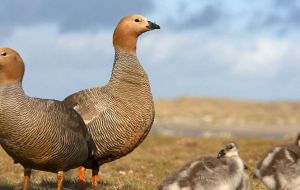MercoPress. South Atlantic News Agency
Chilean scientists studying the impact of invasive species in Tierra del Fuego
 Penguins are the target of foxes that pullulate in Tierra del Fuego
Penguins are the target of foxes that pullulate in Tierra del Fuego  Beavers originally introduced from Canada for a fur industry are now destroying forests
Beavers originally introduced from Canada for a fur industry are now destroying forests  The ruddy headed goose, at risk of extinction, because of hunting, and the fact that it nests in grassy fields, now occupied by guanacos and roaming foxes
The ruddy headed goose, at risk of extinction, because of hunting, and the fact that it nests in grassy fields, now occupied by guanacos and roaming foxes Chilean scientists with teams of students are analyzing the impact of invasive or introduced species in Tierra del Fuego on autochthonous fauna, such as the case of some King Penguin rookeries that have become the target of foxes targeting their chicks.
Carlos Zurita, Biology professor from the Scientific Research Center, linked to the Pontific Catholic University of Chile, every summer invites young students to camping expeditions to learn about the Tierra del Fuego fauna.
The King Penguins rookery under study is at the mouth of the Marazzi river which flows into the Inutil Bay, southwest of Punta Arenas. According to the research, penguins are changing their habits and becoming somehow more aggressive, to combat foxes which prey on their chicks. The research has been ongoing since 2014, with different teams.
The Chilla fox was originally introduced in Tierra del Fuego in 1951 with the purpose of controlling a plague of rabbits, which finally ceased to exist, not because of the invasive predator, but because of a virus. Foxes have since multiplied and in a 2008 census it was estimated the population was in the range of 40,000. Foxes together with an autochthonous endemic rodent, Magallanes tucu-tucu, since 2020, are also going after penguin chicks.
Another project under the guidance of professor Zurita are beavers, an invasive species which is destroying the original forests of lenga beech trees in the area of the Santa Monica lake. Beavers modify the scenery with the construction of holts, mainly made out of trees, branches, even bones leaving some birds without their habitats.
However there are two species that benefit from the devastation of forests, according to professor Zurita. One of them is the guanaco, from the camelids family, a South America native which prefers arid soils from Peru to Tierra del Fuego, which with cleared spaces of forests enjoys greater spaces to feed and reproduce. The second is the red caiquén, or ruddy headed goose, (with cousins in the Falklands), which is at risk of extinction, because of extensive hunting, and the fact that it nests in grassy fields, now occupied by guanacos, foxes and even sheep farming.
According to professor Zurita, there are studies from the University of Chile showing the damage done to biodiversity by the beavers in Tierra del Fuego, which were introduced from Canada in 1946 with the purpose of developing a fur industry. Finally although there are positive and negative effects of the invasive species, the damage done by beavers far exceeds, and for example, the devastation at the Karukinka National Park is overwhelming.
Zurita and his team of rotating summer students have been studying and monitoring Tierra del Fuego fauna for the last eight years. “They come mostly from Santiago and then make regional biology tours and even attend international scientific conferences. The findings on the King Penguins have been shared in meetings held in Mexico, Abu Dhabi and Belgium”, he said.




Top Comments
Disclaimer & comment rulesCommenting for this story is now closed.
If you have a Facebook account, become a fan and comment on our Facebook Page!